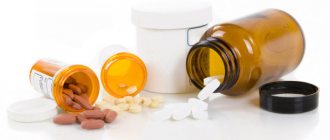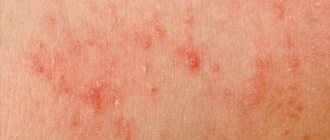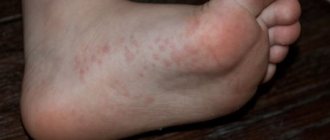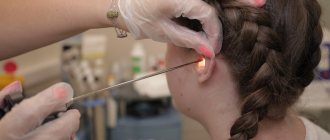Normal breast skin should be soft to the touch, clean, elastic, without bruising, peeling, redness, spots or rashes. Any deviation from the norm should be a reason for consultation with a specialist.
Redness of the mammary glands can occur for a number of reasons, including diseases of various natures, tumor processes, allergic reactions, injuries, wearing low-quality synthetic underwear, etc.
Causes of spots and additional signs: table of symptoms
If you find yourself with a spot, check the symptom chart. Some spots are not dangerous and do not even need to be treated. Others are a beacon of serious illness. A spot in the bust area may appear:
- due to allergies (food, care products, synthetic underwear);
- traumatic injury;
- insect bite;
- disruption of the gastrointestinal tract;
- as a result of dyschromia (pigmentation disorders due to stress, metabolic disorders, ovarian dysfunction), for example, vitiligo;
- parasitic diseases;
- fungal infections.
| Spot color | Description of the spots | Additional signs | Possible cause of the problem |
| Red or pink | Purple spots between the breasts (breasts) | Scratches and pain | Tissue damage from bra underwire |
| Urticular (like tubercles) scarlet under the breasts, on the chest, back, neck | Severe itching, rapid increase in area of rashes | Urticaria (food allergy) | |
| Spots in the bust area, small in size, sometimes looking like small bumps or blisters | Sometimes itchy. Sometimes spots appear asymptomatically or due to insomnia | Excessive excitement. Stress Changes in temperature and humidity conditions | |
| Crimson small formations | Itching | Contact dermatitis | |
| Small spots on the bust and abdomen | Mild itching | Miliaria (appears in summer). Drug allergy. | |
| Spots on the bust, neck and abdomen | Itching, pimples, peeling | Eczema developed due to damage to the gastrointestinal tract, due to genetic predisposition or weak immunity | |
| Education in the field of mammary glands | Increase in local temperature, compaction | Lactostasis | |
| Single scarlet spots similar to herpetic formations | Itching, weeping, small bleeding sores, skin erosion and changes in the shape of the nipple | Paget's cancer | |
| Spots in the mammary glands | Hyperemia of the skin of the bust (redness), increased local temperature, thickening of the skin, swelling and pain | Erysipelas-like cancer, characterized by vascular reaction and rapid proliferation of atypical cells | |
| Protruding formation on the skin, congenital or acquired | No | Mole | |
| Minor rashes | Papules, weeping, itching, scabs (crusts) | Herpes | |
| Extensive lesions on the chest and under the breasts | Redness, itching, peeling | Fungus | |
| Redness in the breast area | Increase in local and general temperature, compaction | Mastitis | |
| Brown | Congenital formation, can be of any shape (usually round) from light brown to black | No | Birthmark (mole) |
| A growth that rises above the surface of the skin, pigmented tissue that is spongy | No | Wart | |
| Light brown formations on the skin are initially isolated, then spreading over the entire surface of the bust and abdomen | The spots are slightly flaky and itchy. | Versicolor/pityriasis versicolor | |
| Light-brown (less often scarlet-reddish) areas on the skin of the gland with a diameter of 10 mm, over time merging into one pigmented area the size of a palm | Reduction in the size of the affected gland, hardening and thickening of the skin | Armored cancer | |
| From light to dark brown spots of different sizes | Flat or slightly raised above the surface | Pigment spots. Age-related hyperkeratosis | |
| Blue | The formation looks like a hematoma, single | The compaction is palpable | Nodular form of cancer |
| Formation of blue, greenish, yellowish color | Pain, swelling. During the healing stage, the breasts are slightly itchy | Hematoma | |
| White | Spots of different sizes | White strand (piebaldism). Spots on the face, abdomen (vetiligo) | Leucoderma (piebaldism, vitiligo) |
| Depends on the cause of pigmentation changes | Consequences of psoriasis, favus, eczema, lichen | ||
| Consequences of stress or inflammation. Pigment cells (melanocytes) die due to acute vascular spasm | |||
| Black | Formations of different sizes, flat or raised above the surface of the skin | Sometimes hair grows from the formation | Melanocytic nevus (mole) |
| Formations of different sizes | Spots during pregnancy on the neck and chest of women | Chloasma (melasma) or melasma | |
| Hyperpigmentation (dark, almost black, coloration of the skin) | Symmetrical hyperpigmentation of the neck, feet, intergluteal fold, in the groin, around the lips and armpits, papillomatosis (extensive growth of papillomas), hyperkeratosis (thickening of the skin). | Acanthosis nigricans (negroid) |
Regardless of whether you have one small dark spot or your chest is covered with a scarlet rash, consult a doctor: a dermatologist, mammologist, allergist.
Types of spots on the sternum in women
Doctors identify several main types of spots, which can be used to identify a problematic organ or even a disease in the body. It is advisable to start taking measures immediately after symptoms appear; in the future, this will save a lot of time and effort and will help maintain the health of the body.
Brown
Initially, one small spot appears, the skin on which begins to peel off.
The disease progresses and several spots appear, they are very itchy and inflamed. Doctors recommend using medicinal ointments and nitrofungin solution.
What could cause:
- allergic reaction of the body (brown spots appear rarely);
- lichen;
- cancer;
- insect bites;
- constantly being in stressful situations.
If you do not monitor the course of the disease from the very beginning, the brown spots merge into solid ones, and the itching becomes stronger. This type of spots indicates the presence of lichen or armored cancer. Both diseases need to be noticed at an early stage to prevent the patient’s well-being from deteriorating.
Note! In the case of cancer, you should be careful; if you start therapy with an undeveloped tumor, the chance of recovery is about 50-80%, depending on the organ affected by cancer.
Reds
The causes of redness of the skin in the chest area are varied. This may be related to the immune or hormonal systems, but in most cases, red spots appear when:
- vegetative-vascular dystonia;
- mastitis;
- cancer;
- skin diseases, such as urticaria;
- food allergies.
Red spots cause more discomfort than brown ones. It's easier to notice them. You should not ignore the appearance of redness, because it signals a person that there is some kind of health problem.
If treatment is delayed, the disease will enter an extremely severe phase, so in case of mastitis, it is possible to perform an operation, during which a breast incision will have to be made.
Note! In the case of a breast cancer tumor, if therapy is not carried out on time, death is possible. It is better not to ignore problems associated with the chest area.
Small specks
The most common cause of chest rash is urticaria. This disease occurs quite often in pregnant women and can signal that there is some kind of malfunction in the body.
If the following symptoms appear along with small red spots, you need to take urgent measures and go to the clinic:
- temperature rises;
- there is a headache;
- dizziness;
- eyes become inflamed;
- inflammation of the mucous membranes.
If the red spots itch and at least one of the symptoms is present, then it could be measles. When starting treatment, you should know that the rash will go away only two weeks after the final recovery.
If, during the course of the disease, the lymph nodes become inflamed, and the temperature remains high only for a short period of time, then this is rubella.
Rubella is an infectious viral disease; in most cases, a woman survives the disease without complications, but there are exceptions. However, the virus is quite easily transmitted to others, so during treatment it is better to avoid long-term contact with people.
Diagnostics
Depending on the symptoms that arise against the background of breast redness, doctors distinguish different diagnostic methods. After such symptoms appear, you must consult a doctor and undergo all tests.
Self-diagnosis
If the disease is mild and it is at an early stage, then you can do the diagnosis yourself, without a doctor. To do this, you need to examine the spots and palpate the chest - you need to report all changes to the doctor. In the mirror you need to examine your mammary glands for changes in their size and shape
It is also worth paying attention to the shade of the breast and nipple itself.
It is important to consult a doctor, tell about your complaints and noticeable changes. Self-examination should be carried out according to a certain pattern
Self-examination should be carried out according to a certain pattern.
How to do self-diagnosis
If cancer and mastitis are not detected during the examination, you can continue treatment at home.
Clinical methods
If you suspect a serious illness, you should immediately consult a doctor and undergo an examination. Before going to the doctor, you need to take a blood test and biological material for a detailed analysis. To identify these diseases, it is necessary to undergo other tests:
- To identify mastitis, consult a surgeon and mammologist. It is necessary to undergo an ultrasound of the mammary glands, mammography and a full examination of the fluid secreted from the nipples.
- For breast cancer, it is necessary to undergo tests for markers to determine the type of tumor and a biopsy.
Diagnosis of red spots on the chest in women
If redness is detected on the chest, it is necessary to try to detect additional symptoms for a detailed description to a specialist. This information will help you quickly identify the disease and prescribe appropriate examination and treatment.
The main thing is not to delay going to the doctor, since some diseases can become chronic or enter the final stage, when specialists will be powerless.
Which doctor should I go to?
The diagnosis can be made by a mammologist, dermatologist, or allergist. It all depends on the symptoms and the underlying cause. To be more confident, it is recommended to go through all the doctors.
Any doctor will first order a blood test. The following activities may follow:
- Ultrasound;
- scraping;
- mammography;
- ductography;
- puncture;
- if tumor-like thickenings are suspected, a biopsy may be necessary.
Detailed and high-quality diagnostics will help to identify life-threatening diseases in the early stages, as well as carry out a number of procedures to improve health.
Treatment methods
In medicine, there are three options: surgery, radiation therapy and chemotherapy.
- The area infected with the tumor is surgically removed. Here, a distinction is made between organ preservation (removal of the site of infection) and mastectomy (removal of the breast).
- Radiation therapy uses radiation.
- Chemotherapy uses special drugs. Depending on the stage of the disease, these methods can be used either separately or together.
It is also important to conduct preventive examinations, both with a doctor and to independently perform self-examination of the mammary glands
Treatment for red breasts
Treatment of breast congestion is carried out depending on the cause of the disease. Inflammation of the mammary glands with the formation of a purulent infiltrate requires surgery to remove it and further anti-inflammatory treatment. An allergic reaction that causes redness of the chest can be controlled by taking antihistamines, excluding the irritating effects of allergens.
Therapy for dermatological skin diseases includes taking antimicrobial, anti-inflammatory, antihistamine drugs and local use of medicated creams, gels and ointments. Treatment for neurological redness involves taking sedatives and medications that increase stress resistance.
Diagnosis and treatment of various neoplasms of the mammary glands or breast skin is carried out by an oncologist after determining the nature of the neoplasm. Malignant tumors are usually removed surgically, during which the pathological area, part of the gland or the entire breast and nearby lymph nodes are excised. Then radiation and chemotherapy are carried out.
When your breasts are red, it is important to wear underwear made from natural materials and avoid the negative effects of household chemicals and allergens.
Diagnosis of the causes and treatment of breast redness in a multidisciplinary department is carried out by highly qualified specialists in the field of dermatology, oncology, allergology, and mammology. The clinic’s patients have access to a modern diagnostic laboratory, which carries out a wide range of laboratory tests, as well as modern diagnostic equipment of an expert level, which makes it possible to provide medical services at the level of world standards of treatment.
Treatment
Once the causes of the disease are identified, the doctor will prescribe treatment. You should not self-medicate, as you can further harm your health.
Cancer
Even after identifying cancer, the doctor must identify its stage and type of tumor. To treat this disease, the following healing techniques can be adopted:
Surgical intervention. If the cancer has progressed, it may require complete or partial removal of the breast.
Breast cancer surgery
- Hormone therapy. The doctor may prescribe the woman to take hormones in order to reduce the size of the tumor and reduce the number of hormones that are in the body.
- Radiation therapy. In advanced stages of the disease, radiation removal of the cancer is necessary.
- Targeted therapy. The doctor prescribes special drugs to the patient to destroy infected cells.
In addition, chemotherapy is necessary for cancer. In some cases, your doctor may recommend breast plastic surgery to improve your bust shape. But this therapy is not mandatory and is carried out after general treatment.
Mastitis
The main treatment measure for mastitis can be called constant expression of milk, due to which it will be possible to break up existing formations. If the disease is severe, the doctor prescribes medication or surgery. The operation is prescribed in the following cases:
- the pain does not stop;
- temperature persists longer than 2 days after treatment;
- the woman's general condition worsens.
Need to get rid of pus
The operation is performed under general anesthesia: it is necessary to make an incision in the chest and extract pus, abscess and dead tissue from there. After cleansing your breasts, you need to rinse them well.
In the postoperative period, it is important to take medications, one of which is an antibiotic. The products must be taken for at least 5 days, even if improvements are noticed
!During mastitis, you cannot stop breastfeeding, even if the pain is unbearable, as this will cause even more stagnation.
Skin diseases and allergies
After the appearance of spots or irritation, you must consult a doctor for a diagnosis, since skin diseases can have a different nature. Treatment should be continued for several weeks. The main measures are:
- antihistamines;
- sedatives;
- antibiotics (in advanced stages);
- physiotherapy.
The same healing techniques are prescribed for people whose chest redness is caused by stress and anxiety. But to combat yourself, it is recommended to visit a psychiatrist.
Red spot on the chest: treatment
Treatment is prescribed by the attending physician. Most often it is medicinal.
The specialist prescribes treatment based on an accurate diagnosis.
- In the case of an allergic reaction, an antigen is first detected. Then contact with the identified irritant is minimized. After which complex treatment is prescribed. Antihistamines are prescribed to relieve swelling, as well as ointments containing hormones that help with itching and burning.
- If prickly heat is detected, it is necessary to wear breathable, loose clothing, lubricate the area with either ointment or herbal decoction and take a shower daily.
- For mastitis, the doctor prescribes ointments and creams that relieve inflammation, expressing milk (if the woman is breastfeeding), and additionally, therapeutic massage.
- If the cause of redness is cancer, then the stage is first determined, after which medications, surgical removal of the tumor, and a series of chemotherapy measures are prescribed.
When the cause of redness is a psychological disorder, the treatment is medications to normalize the nervous system.
In what cases do spots go away without requiring treatment?
In the case where increased melanin production is caused by a physiological reason (for example, hormonal changes during pregnancy), pigmentation can go away on its own, leaving no traces behind. As a rule, after delivery, such neoplasms disappear after a few months.
If after childbirth skin defects remain and are present for 1 year or longer, it is recommended to consult a cosmetologist or dermatologist to remove them. Neoplasms that appear during menopause go away on their own. After normalization of hormonal levels, the skin is restored and its original color returns.
When melanin production increases due to the development of a specific disease, it is necessary to undergo specific therapy to eliminate it and, after that, a visit to a cosmetologist to remove hyperpigmentation.
Brown and dark spots
First, you can replace one small spot on your chest that is slightly peeling. As a result of the development of the disease, their number and size increase, and peeling intensifies. They begin to itch, hurt and itch. The causes of brownish spots may be:
- Allergy
- Cancer
- Lichen
- A bite of an insect
- Regular stress
If you do not pay attention to the spots from the moment they appear, the brown spots begin to merge into one whole
It is better to pay attention to the disease immediately so as not to cause a worsening of the condition. Brown spots can be birthmarks, in this case there is no reason to worry or need treatment
Clinical researches
La-Cri cream is intended to relieve symptoms of hypersensitivity and inflammatory manifestations on the skin - redness, irritation, itching, rashes and peeling. Effective for relieving itching after insect bites and plant burns.
It has been clinically proven that La Cree cream for sensitive skin reduces itching and irritation, relieves skin redness, moisturizes and gently cares for the skin.
Sources:
- Smirnova G.I. Atopic dermatitis and skin infections in children, Russian pediatric journal, 2014
- N.L. Rybkina, Modern approaches to newborn skin care: pediatrician tactics, journal Bulletin of Modern Clinical Medicine, 2014
- I.I. Ryumina, V.V. Zubkov, Newborn skin care, Healthy Child magazine, 2017
Why does redness appear on the chest?
The appearance of red spots in the chest area in women may be due to transformations occurring in the body. Redness can appear as a reaction of the body to everyday circumstances, or it can be a serious deviation of the body’s vital functions.
The most insignificant problems at first glance have a chance to turn into a dangerous disease if you do not pay any attention to them at the first manifestations.
A variety of reasons cause redness: a reaction to medications, drug use, food additives, alcohol consumption. And various skin diseases, pigmentation, pregnancy can trigger the appearance of skin changes.
But still, the most common causes of redness are:
- Allergy;
- Instability of emotional state;
- Fungal infections of the skin;
- Moles;
- The appearance of eczema;
- Oncology.
Allergic reactions cause itching of the skin. The reactions are dangerous. The main thing is to find allergens to which the body reacts.
Common causes of allergies are:
- Food. The greatest number of allergens are found in foods: tuna, salmon, beef fillet, chicken breasts, milk, peanuts, soybeans, chocolate, honey.
- Household allergens. Household allergens include: dust, household chemicals, animal hair, down and bird feathers.
- Medicinal substances - occurs as a result of the action of drugs on the body. Skin dermatitis and urticaria are a consequence of drug allergies.
- Cosmetical tools. When using body products that contain irritating components.
- Ultra-violet rays. A skin reaction caused by exposure to ultraviolet radiation may be called a sun allergy. Existing skin problems usually get worse in the sun.
- Infectious skin diseases. Microorganisms, cocci, pathogenic fungi, parasites cause redness on the human chest.
- Emotional stress. A certain group of people have an unstable emotional state, which provokes the appearance of allergies on the face.
There are red rashes on the chest, which are associated with the reaction of blood vessels to a person’s nervous overstrain. With these skin reactions and confidence in their connection with disorders of an emotional nature, it is necessary to reduce the load and give the body a rest.
Red-brown spots will be a manifestation of fungal diseases. They usually have the defined borders characteristic of fungal infections and cause severe itching. They can be located on the chest and other parts of the body.
Birthmarks on the chest and moles do not cause concern and do not pose a danger to the body. But this happens if the moles do not change their color, size and shape
If any changes are noted, you urgently need to pay attention to it and seek advice from a doctor
Changes in the skin, which are characterized by spots of this color on different parts of the patient’s body, is eczema. They are bright, itchy and weeping.
Oncology is characterized by the appearance of a spot on the chest, in its place a lump can be felt. The location is often the area around the nipples. The spots are usually red or pink. If they become red, the situation is considered serious and consultation with a specialist is necessary.
The reasons for the appearance of spots in the chest area are different, but they should always alert the patient and give him a reason to consult a specialist. These reactions are often not typical for diseases that are life-threatening.
Often a sick person is diagnosed with cancer. The outcome of treatment depends on the timely diagnosis.
When breastfeeding, redness in the chest area may occur. The spots are so painful and accompanied by swelling.
This is the first sign of mastitis. Mastitis can develop in a woman outside the lactation period, then it is called non-lactational.
Red spots in the chest area: possible diseases
If you notice round, small or flaky redness in the chest area, do not rush to label it “cancerous tumor”. To begin with, you should carefully examine the spots that have arisen: where they appeared, their size, color, whether the skin is peeling, whether there is itching or any other unpleasant sensations.
Many diseases have the same symptoms, so it is extremely difficult to make a diagnosis on your own without examining a doctor and taking tests.
The colors of the spots can be the following:
- red;
- white;
- brown;
- purple;
- pink.
Some diseases may be the cause:
- Candidiasis. This is a fungal infection that often develops in the folds of the skin: the skin under the breast is no exception.
- Eczema. A malaise in which the chest turns red, as well as itching, burning and peeling of the skin.
- Scabies. Caused by microscopic mites that burrow under the skin. Transmitted from person to person.
- Lichen. It is transmitted from animals and also from people. The affected area is itchy, pink and flaky.
- Psoriasis. A chronic disease in which scales form on the red spot.
- Hives. They are small blisters on the skin caused by allergens.
- Syphilis. A dangerous disease transmitted through sexual intercourse. The primary symptom is raised red spots with a small ulcer. They can appear on any part of the body, including the chest.
- Erythema. This viral disease is expressed in the form of a lace mesh on the skin. It may disappear on its own within a few days and return after a while. The main symptoms include: fever, weakness, muscle aches, lack of appetite.
- Diabetes. Red spots may be the first sign of diabetes.
Below are possible places and causes of the appearance of a red spot.
On the chest
Most often, red spots on the chest or under the breasts appear for the following reasons:
- Allergy. Redness can occur due to wearing low-quality clothes made of synthetic materials, consuming allergenic products, using cosmetics, flowering, dust, and pet hair. If you have started taking any medications, this can also cause spots on the skin of your chest.
Please note: When taking birth control medications, redness may appear in the breast area. Therefore, this method of contraception should be agreed upon with a gynecologist.
- Incorrectly chosen bra. A bra that is the wrong size, too tight, or made from unnatural fabric can rub the skin or cause diaper rash, and as a result, redness.
- Excess weight. Including if a woman has large breasts.
- Failure to comply with personal hygiene rules. It is recommended to shower twice a day. Especially if you are actively involved in sports. Poor hygiene can also lead to prickly heat, which in addition to itching can cause sensations such as burning, as well as the appearance of microcracks.
- Physical activity: After playing sports, purple spots may appear in the chest area.
- Unstable emotional state. Nervous breakdowns, stress, and anxiety lead to redness.
- Age-related changes. Basically, age-related changes in the body occur with the appearance of brown spots both on the chest and on other parts of the body.
- Reaction to the sun. With prolonged exposure to the sun, white spots appear on the skin. The spots can be either small or large.
- Injury.
On the mammary gland
About 30 hormones are responsible for the condition of the breasts in a woman’s body. And if any inflammatory process occurs, the breast begins to react to it. Pain, swelling, and increased breast temperature appear. This phenomenon can occur, for example, before the onset of menstruation.
Red spots on the mammary glands
The most common disease is mastitis. The condition causes inflammation of the mammary gland. Symptoms include: redness of the breast, fever, pain when touched. The disease occurs mainly in women who are breastfeeding.
Since milk is retained in the breast, an inflammatory process begins, which can subsequently lead to the formation of pus in the mammary gland. Delayed examination may require surgery in the future.
Important information: During pregnancy, brown spots may appear due to hormonal levels. As a rule, this is a temporary phenomenon and is not a serious problem.
There are episodes of mastitis when a woman does not breastfeed. In this case, the causes may be an infection that entered through the nipple, as well as injury or hypothermia.
Breast abscess is a serious disease in which pus forms and accumulates in the breast due to infection through the nipple.
An abscess is also common mainly in breastfeeding women and may be the result of mastitis.
In addition, it may occur due to hormonal imbalance, endocrine system disorders or other inflammatory processes in the body.
The symptoms are similar to mastitis, but there is also a painful pulsation of the mammary gland, which becomes more intense with movement and physical activity.
One of the possible breast diseases is ectasia of the mammary glands. This is a benign thickening of the walls of the breast ducts. The danger lies in their blockage, and as a result, the accumulation of fluid.
The condition is accompanied by bloody discharge from the nipples, redness of the breasts, increased local temperature and pain in the area of the areolas and nipples.
Red dots on the chest rarely indicate the presence of a malignant tumor. But there is a rare form of cancer - inflammatory. According to studies of patients with this form, about 3%.
Inflammatory cancer is not characterized by the formation of lumps: it affects the skin of the breast and lymphatic vessels.
The symptoms are as follows: the chest becomes covered with red spots and the temperature rises, the skin thickens, the mammary glands become enlarged, swelling forms that constantly itches, and small dimples appear on the skin.
On the nipple
Spots on the nipples can be a symptom of the following diseases:
- Eczema is an acute inflammation of the nipples, characterized by red spots, itching and burning.
- Paget's disease is most often localized to one nipple and in women over 50 years of age. First, the nipple is affected, and after a while the area around the nipple (areola). The disease is very easy to confuse with eczema, but it is important to notice the following symptoms: thickened red skin, flaking, dryness, discoloration, pain, itching, protruding fluid (possibly bloody discharge).
- Dermatitis is an inflammation of the nipple and the area around it. The disease is typical for women who are breastfeeding. Causes itching, flaking, dry skin. Occurs due to irritation, allergies, infections caused by fungi, viruses or bacteria.
- Nipple thrush is a fairly rare occurrence that affects breastfeeding women. Since a favorable environment for the proliferation of bacteria and infections is created, inflammation of the nipple begins. Symptoms include: swelling and red color of the nipple, a film, small cracks or red dots appear on the areola.
Diagnostics
Based on the clinical picture, as well as the development of pathology, different examination methods are used. If the disease is mild, self-diagnosis is possible. It includes an initial examination of the spots where the spots are located, as well as their subsequent palpation. In the absence of signs of cancer or mastitis, treatment of an external cosmetic defect is also carried out independently at home. This applies to an allergic reaction, stress, prickly heat, or a side effect from taking medications.
Clinical methods
First, the doctor examines the possibility of the presence of diseases that cause irritation (dermatitis, lichen or allergies). The appearance of red spots on the chest often occurs due to the presence of such diseases. If the listed diseases are excluded, then a number of measures are taken to make a diagnosis. A dermatologist prescribes the following procedures to determine the cause of red spots on the chest:
- Examination and palpation of the breast;
- Blood test for sugar levels;
- Culture for the presence of pathogenic flora;
- Ultrasound;
- Mammography;
- Biopsy or puncture;
- Scraping the affected area.
Therapy methods and drugs
When, based on the tests, the doctor has made an accurate diagnosis, the following therapeutic measures are prescribed to eliminate the cause and rash on the chest in women caused by a specific factor:
- When red dots on the chest occur due to an allergic reaction, which is accompanied by itching, the appearance of a pimply or scaly surface, the patient needs to undergo comprehensive treatment. First, the doctor identifies the allergen, for which a small amount of the possible allergen is injected under the skin. When the exact type is injected, swelling will appear on the skin. For treatment, the following medications are prescribed: antihistamines (Suprastin, Claritin, the use of these drugs is possible even during lactation, due to the absence of a negative effect on the child’s health); hormonal ointments containing hydrocortisone, also known as Elidel - they eliminate itching and reduce redness); hormonal drugs, for example Kenalog (prescribed for allergic dermatitis; for treating pregnant or breastfeeding women, you must first consult a doctor).
- If you have prickly heat, you need to wear loose clothes made from natural materials to allow your skin to breathe. Damaged areas of the skin are treated with special herbal decoctions and a shower is taken every day;
- For psychological disorders, sedatives are prescribed to calm the nervous system;
- In case of eczema, an additional examination is carried out to identify the root cause, due to the impossibility of treating some symptoms;
- For mastitis, massage, regular pumping, the use of medications to reduce fever, and the use of local anti-inflammatory creams or ointments are prescribed;
- With breast cancer, first of all, the stage of development of the disease, as well as the level of localization, is determined. After this, the course of treatment consists of taking medications, surgical removal of the formations, and further radiation and chemotherapy.
Folk remedies
The use of some traditional medicine recipes can eliminate redness of the skin on the chest:
Lemon juice
If a rash appears on the chest, apply lemon juice to the affected area and leave it there for half an hour. Due to its whitening properties, skin redness is eliminated and the skin becomes soft.
Castor oil
Spots on the chest can be eliminated using castor oil. It is applied up to two times a day using cotton wool to the area of skin around the lesion. This has a healing effect and allows you to eliminate external skin defects.
Aloe vera
Gently and gently rub fresh aloe vera gel into the affected area and leave it on the skin for 50 minutes. After this, the area must be rinsed with clean, cool water. Repeat 2 times a day until the desired result is achieved.
Vinegar
Due to certain chemicals found on clothing, red spots may appear on the chest of men or women. To eliminate this defect, vinegar is used:
- You need to mix 100 ml of vinegar with 20-25 liters of hot water, in which to wash clothes, and then dry them in the sun;
- An alternative option is to apply apple cider vinegar to the damaged surface, then wash the skin with soapy water, and then clean but cool. This procedure should be carried out 2 times a day until improvement is achieved.
Diseases that can cause redness of the breast skin
- Inflammatory disease of the mammary glands (mastitis) is the most common cause of breast redness in women during the postpartum period. The inflammatory process occurs due to the penetration of an infectious agent or injury and is accompanied by pain, high fever, and a general deterioration in well-being. Pus accumulates in the inflamed cavity and surgical drainage of the affected area is necessary. Mastitis most often occurs due to improper breastfeeding, due to stagnation of milk in the milk ducts. In this case, it is important not to self-medicate and seek qualified help as soon as possible.
- Tumor diseases. The development of a malignant tumor in the mammary gland may be accompanied by redness and changes in the size of the glands. The pathological area becomes denser to the touch. There is a feeling of fullness in the chest, the nipple is retracted, pathological discharge and other characteristic symptoms may appear. There may be no pain at the initial stage.
- Dermatological pathologies. Redness of the skin is one of the symptoms of many skin diseases. In addition to redness of the breast, eczema, psoriasis, dermatitis or other skin pathologies are accompanied by itching, peeling, rashes, and inflammation of the skin.
- Infectious or viral diseases. If redness of the chest is accompanied by the appearance of skin rashes of various types, then this may be a symptom of infectious or viral diseases - rubella, chicken pox, herpes, etc.
- Allergy. An allergic reaction occurs due to the body’s increased sensitivity to provoking factors – allergens. The latter are chemicals, fluff, dust, animal hair and saliva, food products, etc. In addition to redness of the skin of the body, an allergic reaction may also be accompanied by itching, the appearance of various rashes, scratching, and a slight increase in temperature.
- Severe stress, fear or psychological trauma. Severe nervous excitement can cause redness of the skin of the chest and body, the appearance of red spots, severe itching, increased temperature and blood pressure. Typically, such a pathological reaction is characteristic of easily excitable people with an unstable psyche, an exhausted nervous system, or increased emotionality.
Redness under the breasts can be caused by diaper rash and increased sweating.
If there is redness of the breast, especially when it is accompanied by pain, itching, fever, enlargement of regional lymph nodes, changes in the shape and size of the breast (nipple), or the appearance of palpable lumps, a doctor’s consultation is necessary.
The doctor will conduct a survey of the patient, visual examination and palpation to clarify the cause of redness or refer him for additional studies:
- Ultrasound and/or mammography of the mammary glands;
- puncture of the tumor followed by cytological or histological examination;
- scraping and culture of pathological cells;
- dermatoscopy, etc.
In some cases, consultation with an infectious disease specialist, dermatologist or oncologist may be required.










